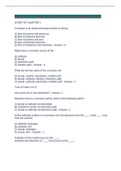NACE CP2 - EXAM (2) QUESTIONS AND ANSWERS 2022
START OF CHAPTER 1
Corrosion is an electrochemical process involving
A) flow of protons and electrons
B) flow of neutrons and ions
C) flow of protons and ions
D) flow of electrons and ions
E) flow of resistance and resistivity - Answer - d
Metal loss or corrosion occurs at the
A) cathode
B) anode
C) electronic path
D) metallic path - Answer - b
What are the four parts of the corrosion cell
A) anode, resistor, electrolyte, metallic path
B) anode, cathode, electron, electronic path
C) anode, cathode, electrolyte, metallic path - Answer - c
True or False (t or f):
Ions exist only in the electrolyte? - Answer - t
Electrons flow in a corrosion cell by which of the following paths?
A) anode to cathode via electrolyte
B) cathode to anode via electronic path
C) anode to cathode via electronic path - Answer - c
At the cathodic surface in a corrosion cell, the electrons from the ____ meet ____ ions
from the solution.
A) cathode, hydrogen
B) cathode, OH-
C) anode, hydrogen
D) anode, OH- - Answer - c
Oxidation of the metal occurs at the ____
surfaces and reduction of ____ ions occurs at the ____.
,A) anodic, hydrogen, cathodes
B) cathode, OH-, anodic
C) anodic, OH-, cathodes
D) cathode, anodic, electrolyte
E) cathode, hydrogen, electrolyte - Answer - a
True or false
Is oxidation necessarily associated with oxygen? - Answer - f
_____ is the measure of the electrochemical difference between two electrodes
in an electrolyte
A) current
B) resistance
C) error
D) ohms
E) ohms-cm
F) voltage - Answer - f
The ________
represents the reversible work to move a unit charge from the electrode surface
through the solution to the reference electrode
A) current potential
B) electrode potential
C) resistance potential
D) ohms potential
E) Faraday potential - Answer - b
Metals occur in nature in the form of various chemical compounds referred to as
___
A) ores
B) anodic metals
C) cathodic metals
D) carbohydrates - Answer - a
The amount of energy required by a metal during the refining
process determines the ___ or _______ of the metal.
A) current, active state
B) voltage, active state
C) active resistance, voltage
D) resistance, active state
E) current, active resistance - Answer - b
,During the refining stage of metal the ____ the energy, the more ____
the metal and the more tendency it has to corrode.
A) higher, inactive
B) lower, active
C) higher, active
D) lower, inactive - Answer - c
What is the most common iron ore?
A) hemophite
B) hematite
C) magnesium
D) calcium
E) aluminum - Answer - b
True or false
Iron is considered thermodynamically unstable? - Answer - t
True or false
Gold is more noble than zinc? - Answer - t
Which of the following metals is most active?
A) magnesium
B) copper
C) iron
D) nickel
E) platinum - Answer - a
Electromotive force (emf), is ____ in sign and magnitude to the electrode potential of
the ___ less the electrode potential of the ____.
A) unequal, cathode, anode
B) unequal, anode, cathode
C) equal, cathode, anode
D) equal, anode, cathode - Answer - d
The driving force for electrochemical corrosion is ____
A) current
B) voltage
C) resistance
, D) ohms
E) siemens-cm - Answer - b
In relation to a corrosion cell, ____ is the net transfer of electric charge per unit time
A) current
B) voltage
C) resistance
D) ohms
E) siemens-cm - Answer - a
If a metallic path connects two electrodes inside an electrolyte, the ____ difference will
cause a
____ to flow between them
A) current, voltage
B) resistance, current
C) resistance, voltage
D) voltage, current
E) current, resistance - Answer - d
The more useful method of organizing metals in order of their tendency to corrode is
_____
A) emf series
B) pgp series
C) nuclear series
D) electron series
E) galvanic series - Answer - e
The ____ expresses the exact electromotive force of a cell in terms of the activities of
products and reactants of the cell
A) Ernest Equation
B) Faraday Equation
C) Ohm's Law Equation
D) Nernst Equation
E) Uniform Equation - Answer - d
Given the Nernst Equation, using the Valence of Common Metals Table, and using the
partial Standard emf Series of Metals solve:
What is the potential of zinc in a 0.01 molar zinc chloride solution at 25C?
A) -0.892V
B) -0.287V




